Law, Society and Controversy
VerifiedAdded on 2023/04/11
|9
|1695
|56
AI Summary
This article explores the concept of equality before the law and the reality of discrimination in society. It discusses the Equality Act of 2010, Article 14 of the European Convention on Human Rights, Human Rights Act of 1998, and Universal Declaration of Human Rights. Case studies highlight instances of discrimination and the challenges of achieving true equality in the legal system.
Contribute Materials
Your contribution can guide someone’s learning journey. Share your
documents today.
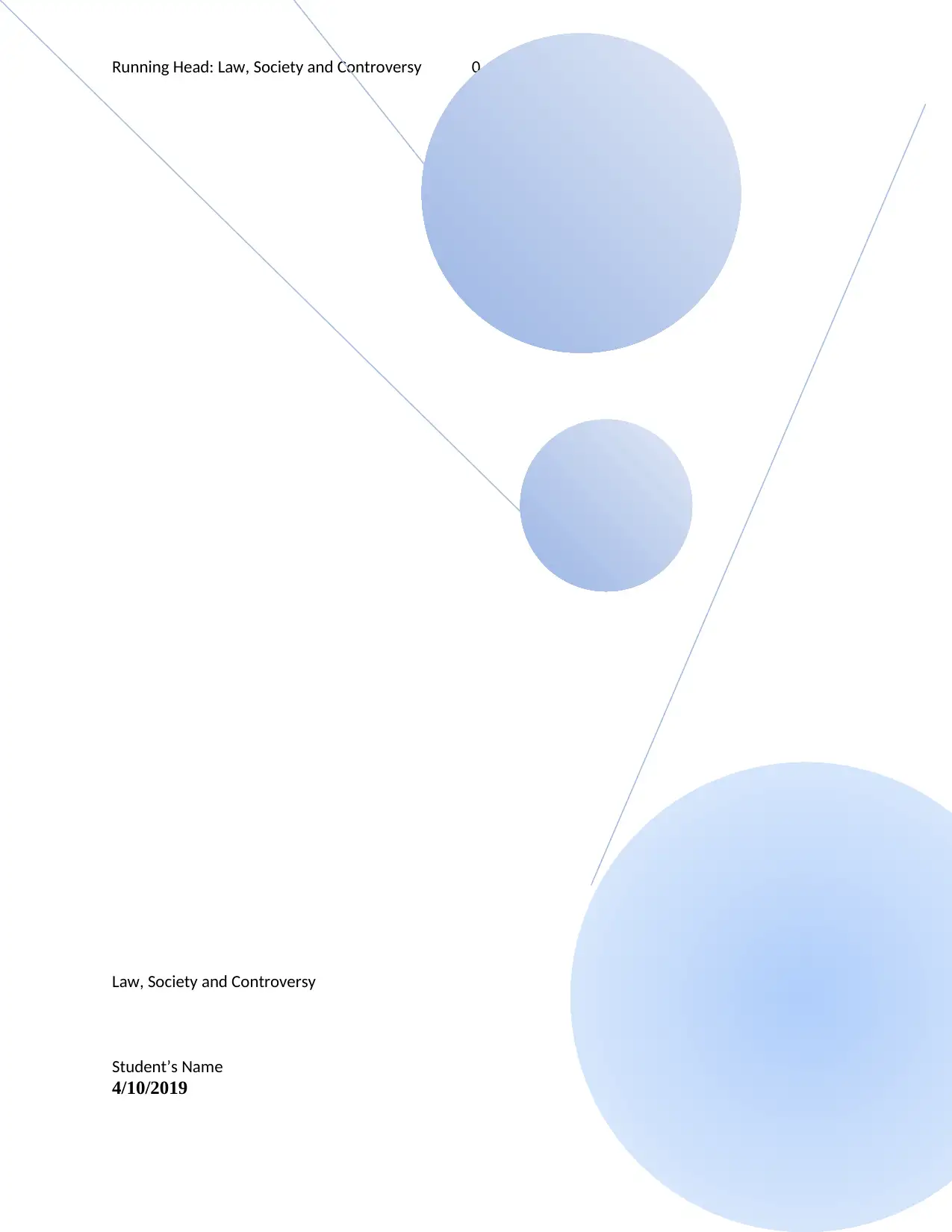
Running Head: Law, Society and Controversy 0
Law, Society and Controversy
Student’s Name
4/10/2019
Law, Society and Controversy
Student’s Name
4/10/2019
Secure Best Marks with AI Grader
Need help grading? Try our AI Grader for instant feedback on your assignments.
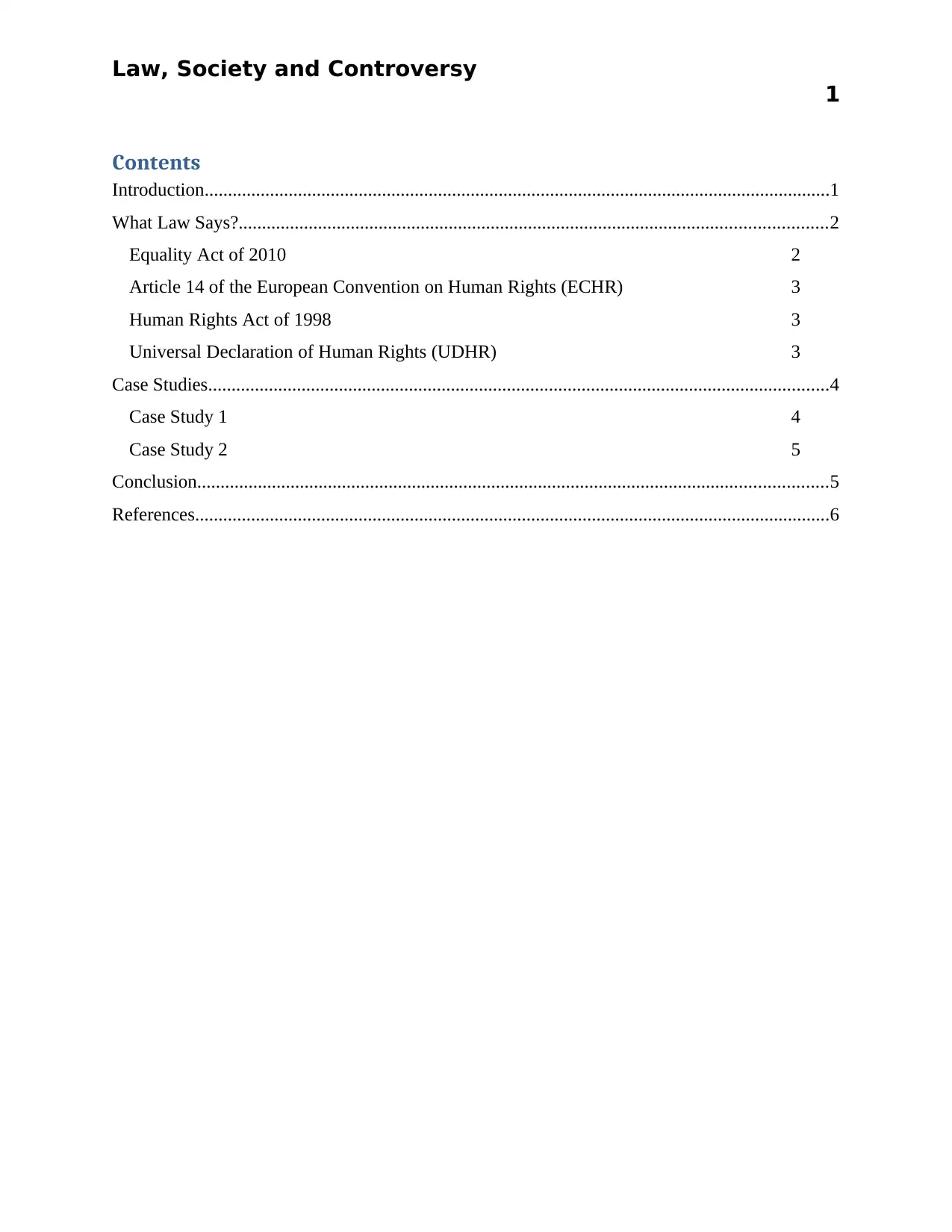
Law, Society and Controversy
1
Contents
Introduction......................................................................................................................................1
What Law Says?..............................................................................................................................2
Equality Act of 2010 2
Article 14 of the European Convention on Human Rights (ECHR) 3
Human Rights Act of 1998 3
Universal Declaration of Human Rights (UDHR) 3
Case Studies.....................................................................................................................................4
Case Study 1 4
Case Study 2 5
Conclusion.......................................................................................................................................5
References........................................................................................................................................6
1
Contents
Introduction......................................................................................................................................1
What Law Says?..............................................................................................................................2
Equality Act of 2010 2
Article 14 of the European Convention on Human Rights (ECHR) 3
Human Rights Act of 1998 3
Universal Declaration of Human Rights (UDHR) 3
Case Studies.....................................................................................................................................4
Case Study 1 4
Case Study 2 5
Conclusion.......................................................................................................................................5
References........................................................................................................................................6
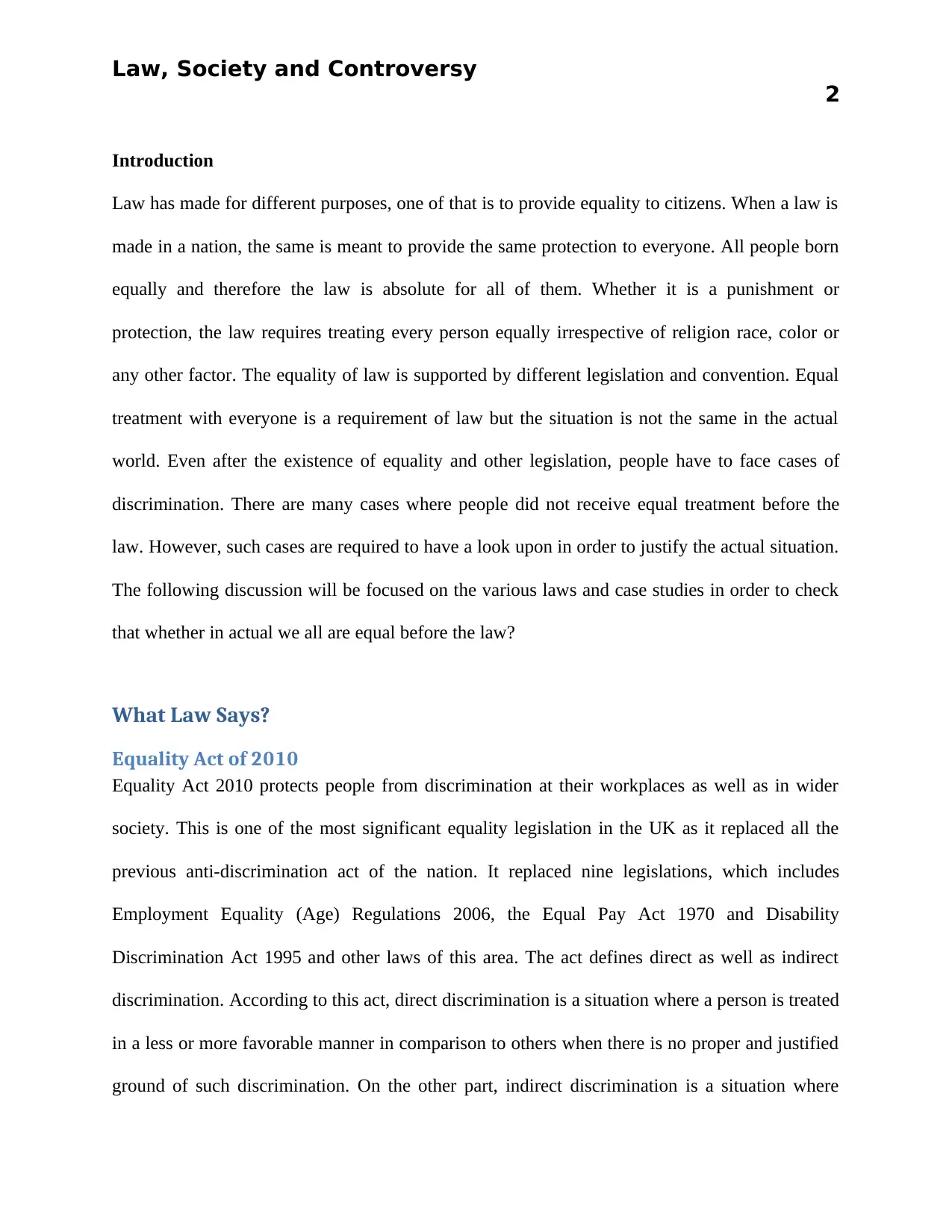
Law, Society and Controversy
2
Introduction
Law has made for different purposes, one of that is to provide equality to citizens. When a law is
made in a nation, the same is meant to provide the same protection to everyone. All people born
equally and therefore the law is absolute for all of them. Whether it is a punishment or
protection, the law requires treating every person equally irrespective of religion race, color or
any other factor. The equality of law is supported by different legislation and convention. Equal
treatment with everyone is a requirement of law but the situation is not the same in the actual
world. Even after the existence of equality and other legislation, people have to face cases of
discrimination. There are many cases where people did not receive equal treatment before the
law. However, such cases are required to have a look upon in order to justify the actual situation.
The following discussion will be focused on the various laws and case studies in order to check
that whether in actual we all are equal before the law?
What Law Says?
Equality Act of 2010
Equality Act 2010 protects people from discrimination at their workplaces as well as in wider
society. This is one of the most significant equality legislation in the UK as it replaced all the
previous anti-discrimination act of the nation. It replaced nine legislations, which includes
Employment Equality (Age) Regulations 2006, the Equal Pay Act 1970 and Disability
Discrimination Act 1995 and other laws of this area. The act defines direct as well as indirect
discrimination. According to this act, direct discrimination is a situation where a person is treated
in a less or more favorable manner in comparison to others when there is no proper and justified
ground of such discrimination. On the other part, indirect discrimination is a situation where
2
Introduction
Law has made for different purposes, one of that is to provide equality to citizens. When a law is
made in a nation, the same is meant to provide the same protection to everyone. All people born
equally and therefore the law is absolute for all of them. Whether it is a punishment or
protection, the law requires treating every person equally irrespective of religion race, color or
any other factor. The equality of law is supported by different legislation and convention. Equal
treatment with everyone is a requirement of law but the situation is not the same in the actual
world. Even after the existence of equality and other legislation, people have to face cases of
discrimination. There are many cases where people did not receive equal treatment before the
law. However, such cases are required to have a look upon in order to justify the actual situation.
The following discussion will be focused on the various laws and case studies in order to check
that whether in actual we all are equal before the law?
What Law Says?
Equality Act of 2010
Equality Act 2010 protects people from discrimination at their workplaces as well as in wider
society. This is one of the most significant equality legislation in the UK as it replaced all the
previous anti-discrimination act of the nation. It replaced nine legislations, which includes
Employment Equality (Age) Regulations 2006, the Equal Pay Act 1970 and Disability
Discrimination Act 1995 and other laws of this area. The act defines direct as well as indirect
discrimination. According to this act, direct discrimination is a situation where a person is treated
in a less or more favorable manner in comparison to others when there is no proper and justified
ground of such discrimination. On the other part, indirect discrimination is a situation where
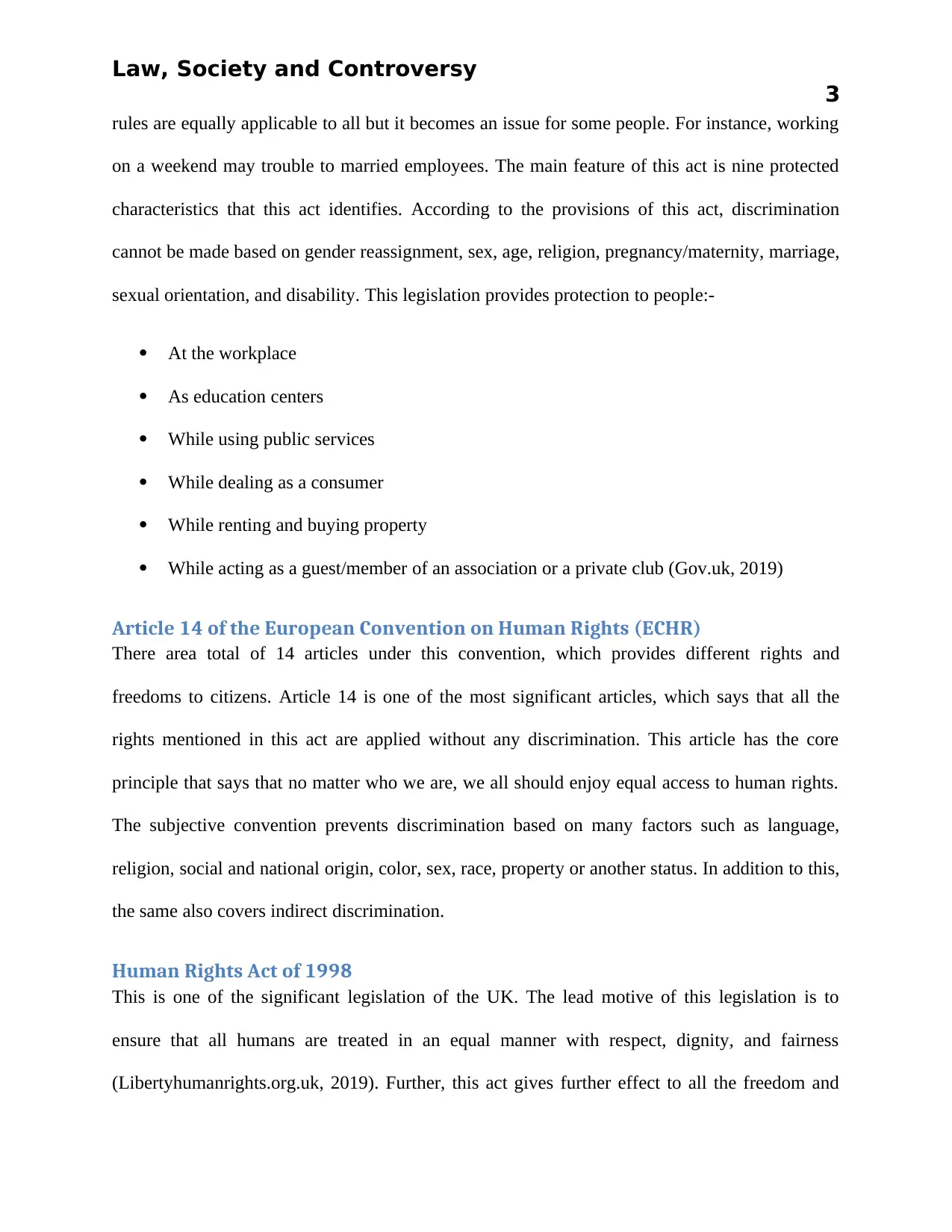
Law, Society and Controversy
3
rules are equally applicable to all but it becomes an issue for some people. For instance, working
on a weekend may trouble to married employees. The main feature of this act is nine protected
characteristics that this act identifies. According to the provisions of this act, discrimination
cannot be made based on gender reassignment, sex, age, religion, pregnancy/maternity, marriage,
sexual orientation, and disability. This legislation provides protection to people:-
At the workplace
As education centers
While using public services
While dealing as a consumer
While renting and buying property
While acting as a guest/member of an association or a private club (Gov.uk, 2019)
Article 14 of the European Convention on Human Rights (ECHR)
There area total of 14 articles under this convention, which provides different rights and
freedoms to citizens. Article 14 is one of the most significant articles, which says that all the
rights mentioned in this act are applied without any discrimination. This article has the core
principle that says that no matter who we are, we all should enjoy equal access to human rights.
The subjective convention prevents discrimination based on many factors such as language,
religion, social and national origin, color, sex, race, property or another status. In addition to this,
the same also covers indirect discrimination.
Human Rights Act of 1998
This is one of the significant legislation of the UK. The lead motive of this legislation is to
ensure that all humans are treated in an equal manner with respect, dignity, and fairness
(Libertyhumanrights.org.uk, 2019). Further, this act gives further effect to all the freedom and
3
rules are equally applicable to all but it becomes an issue for some people. For instance, working
on a weekend may trouble to married employees. The main feature of this act is nine protected
characteristics that this act identifies. According to the provisions of this act, discrimination
cannot be made based on gender reassignment, sex, age, religion, pregnancy/maternity, marriage,
sexual orientation, and disability. This legislation provides protection to people:-
At the workplace
As education centers
While using public services
While dealing as a consumer
While renting and buying property
While acting as a guest/member of an association or a private club (Gov.uk, 2019)
Article 14 of the European Convention on Human Rights (ECHR)
There area total of 14 articles under this convention, which provides different rights and
freedoms to citizens. Article 14 is one of the most significant articles, which says that all the
rights mentioned in this act are applied without any discrimination. This article has the core
principle that says that no matter who we are, we all should enjoy equal access to human rights.
The subjective convention prevents discrimination based on many factors such as language,
religion, social and national origin, color, sex, race, property or another status. In addition to this,
the same also covers indirect discrimination.
Human Rights Act of 1998
This is one of the significant legislation of the UK. The lead motive of this legislation is to
ensure that all humans are treated in an equal manner with respect, dignity, and fairness
(Libertyhumanrights.org.uk, 2019). Further, this act gives further effect to all the freedom and
Secure Best Marks with AI Grader
Need help grading? Try our AI Grader for instant feedback on your assignments.
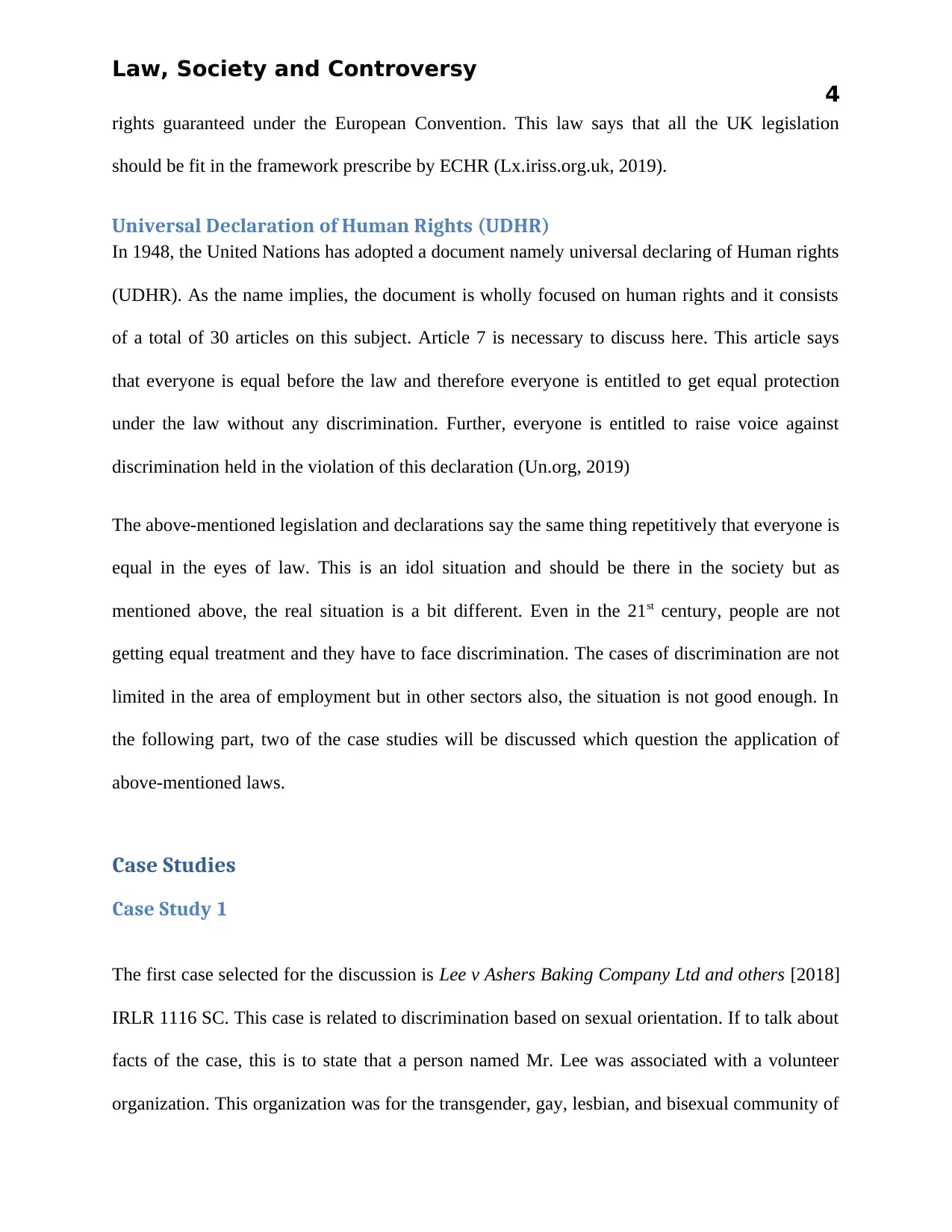
Law, Society and Controversy
4
rights guaranteed under the European Convention. This law says that all the UK legislation
should be fit in the framework prescribe by ECHR (Lx.iriss.org.uk, 2019).
Universal Declaration of Human Rights (UDHR)
In 1948, the United Nations has adopted a document namely universal declaring of Human rights
(UDHR). As the name implies, the document is wholly focused on human rights and it consists
of a total of 30 articles on this subject. Article 7 is necessary to discuss here. This article says
that everyone is equal before the law and therefore everyone is entitled to get equal protection
under the law without any discrimination. Further, everyone is entitled to raise voice against
discrimination held in the violation of this declaration (Un.org, 2019)
The above-mentioned legislation and declarations say the same thing repetitively that everyone is
equal in the eyes of law. This is an idol situation and should be there in the society but as
mentioned above, the real situation is a bit different. Even in the 21st century, people are not
getting equal treatment and they have to face discrimination. The cases of discrimination are not
limited in the area of employment but in other sectors also, the situation is not good enough. In
the following part, two of the case studies will be discussed which question the application of
above-mentioned laws.
Case Studies
Case Study 1
The first case selected for the discussion is Lee v Ashers Baking Company Ltd and others [2018]
IRLR 1116 SC. This case is related to discrimination based on sexual orientation. If to talk about
facts of the case, this is to state that a person named Mr. Lee was associated with a volunteer
organization. This organization was for the transgender, gay, lesbian, and bisexual community of
4
rights guaranteed under the European Convention. This law says that all the UK legislation
should be fit in the framework prescribe by ECHR (Lx.iriss.org.uk, 2019).
Universal Declaration of Human Rights (UDHR)
In 1948, the United Nations has adopted a document namely universal declaring of Human rights
(UDHR). As the name implies, the document is wholly focused on human rights and it consists
of a total of 30 articles on this subject. Article 7 is necessary to discuss here. This article says
that everyone is equal before the law and therefore everyone is entitled to get equal protection
under the law without any discrimination. Further, everyone is entitled to raise voice against
discrimination held in the violation of this declaration (Un.org, 2019)
The above-mentioned legislation and declarations say the same thing repetitively that everyone is
equal in the eyes of law. This is an idol situation and should be there in the society but as
mentioned above, the real situation is a bit different. Even in the 21st century, people are not
getting equal treatment and they have to face discrimination. The cases of discrimination are not
limited in the area of employment but in other sectors also, the situation is not good enough. In
the following part, two of the case studies will be discussed which question the application of
above-mentioned laws.
Case Studies
Case Study 1
The first case selected for the discussion is Lee v Ashers Baking Company Ltd and others [2018]
IRLR 1116 SC. This case is related to discrimination based on sexual orientation. If to talk about
facts of the case, this is to state that a person named Mr. Lee was associated with a volunteer
organization. This organization was for the transgender, gay, lesbian, and bisexual community of
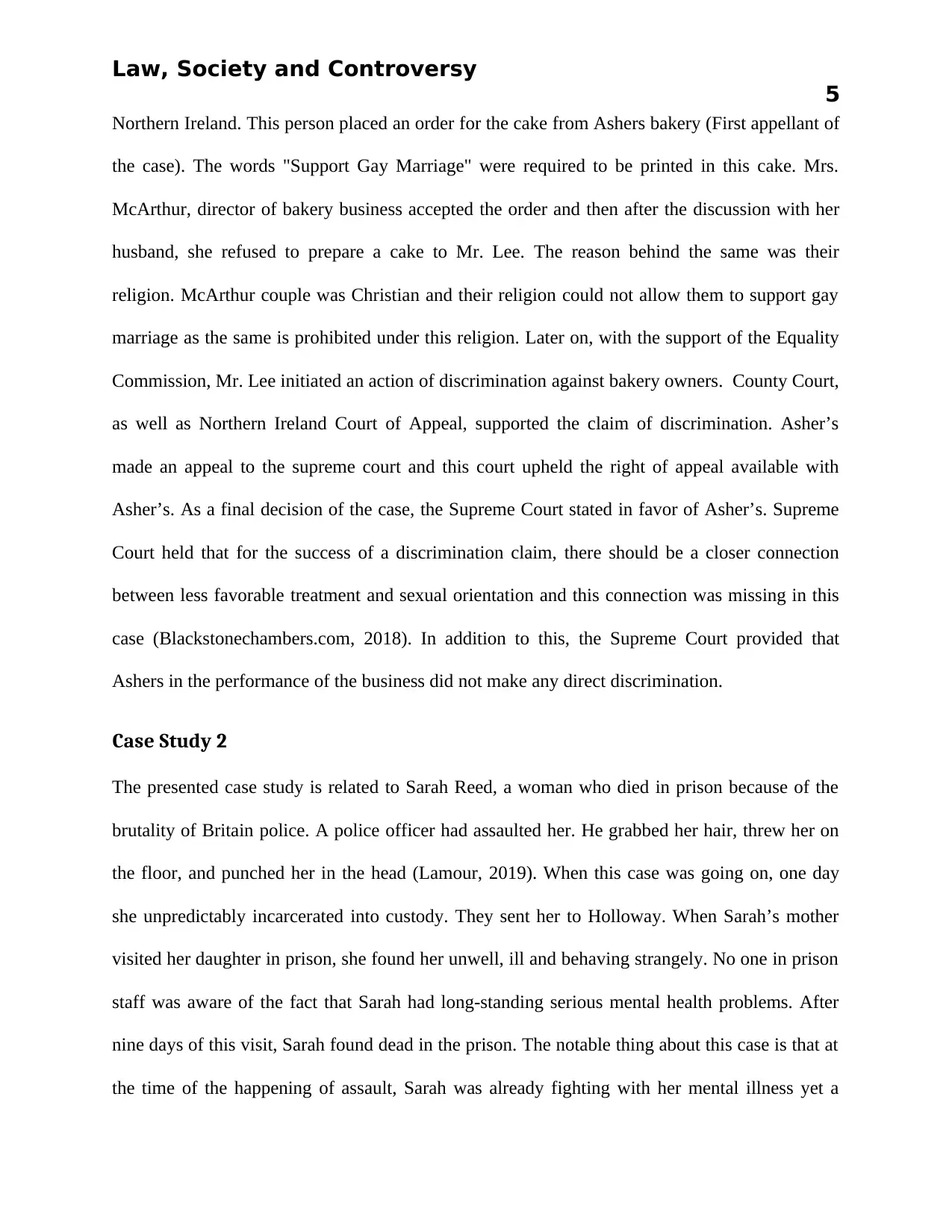
Law, Society and Controversy
5
Northern Ireland. This person placed an order for the cake from Ashers bakery (First appellant of
the case). The words "Support Gay Marriage" were required to be printed in this cake. Mrs.
McArthur, director of bakery business accepted the order and then after the discussion with her
husband, she refused to prepare a cake to Mr. Lee. The reason behind the same was their
religion. McArthur couple was Christian and their religion could not allow them to support gay
marriage as the same is prohibited under this religion. Later on, with the support of the Equality
Commission, Mr. Lee initiated an action of discrimination against bakery owners. County Court,
as well as Northern Ireland Court of Appeal, supported the claim of discrimination. Asher’s
made an appeal to the supreme court and this court upheld the right of appeal available with
Asher’s. As a final decision of the case, the Supreme Court stated in favor of Asher’s. Supreme
Court held that for the success of a discrimination claim, there should be a closer connection
between less favorable treatment and sexual orientation and this connection was missing in this
case (Blackstonechambers.com, 2018). In addition to this, the Supreme Court provided that
Ashers in the performance of the business did not make any direct discrimination.
Case Study 2
The presented case study is related to Sarah Reed, a woman who died in prison because of the
brutality of Britain police. A police officer had assaulted her. He grabbed her hair, threw her on
the floor, and punched her in the head (Lamour, 2019). When this case was going on, one day
she unpredictably incarcerated into custody. They sent her to Holloway. When Sarah’s mother
visited her daughter in prison, she found her unwell, ill and behaving strangely. No one in prison
staff was aware of the fact that Sarah had long-standing serious mental health problems. After
nine days of this visit, Sarah found dead in the prison. The notable thing about this case is that at
the time of the happening of assault, Sarah was already fighting with her mental illness yet a
5
Northern Ireland. This person placed an order for the cake from Ashers bakery (First appellant of
the case). The words "Support Gay Marriage" were required to be printed in this cake. Mrs.
McArthur, director of bakery business accepted the order and then after the discussion with her
husband, she refused to prepare a cake to Mr. Lee. The reason behind the same was their
religion. McArthur couple was Christian and their religion could not allow them to support gay
marriage as the same is prohibited under this religion. Later on, with the support of the Equality
Commission, Mr. Lee initiated an action of discrimination against bakery owners. County Court,
as well as Northern Ireland Court of Appeal, supported the claim of discrimination. Asher’s
made an appeal to the supreme court and this court upheld the right of appeal available with
Asher’s. As a final decision of the case, the Supreme Court stated in favor of Asher’s. Supreme
Court held that for the success of a discrimination claim, there should be a closer connection
between less favorable treatment and sexual orientation and this connection was missing in this
case (Blackstonechambers.com, 2018). In addition to this, the Supreme Court provided that
Ashers in the performance of the business did not make any direct discrimination.
Case Study 2
The presented case study is related to Sarah Reed, a woman who died in prison because of the
brutality of Britain police. A police officer had assaulted her. He grabbed her hair, threw her on
the floor, and punched her in the head (Lamour, 2019). When this case was going on, one day
she unpredictably incarcerated into custody. They sent her to Holloway. When Sarah’s mother
visited her daughter in prison, she found her unwell, ill and behaving strangely. No one in prison
staff was aware of the fact that Sarah had long-standing serious mental health problems. After
nine days of this visit, Sarah found dead in the prison. The notable thing about this case is that at
the time of the happening of assault, Sarah was already fighting with her mental illness yet a
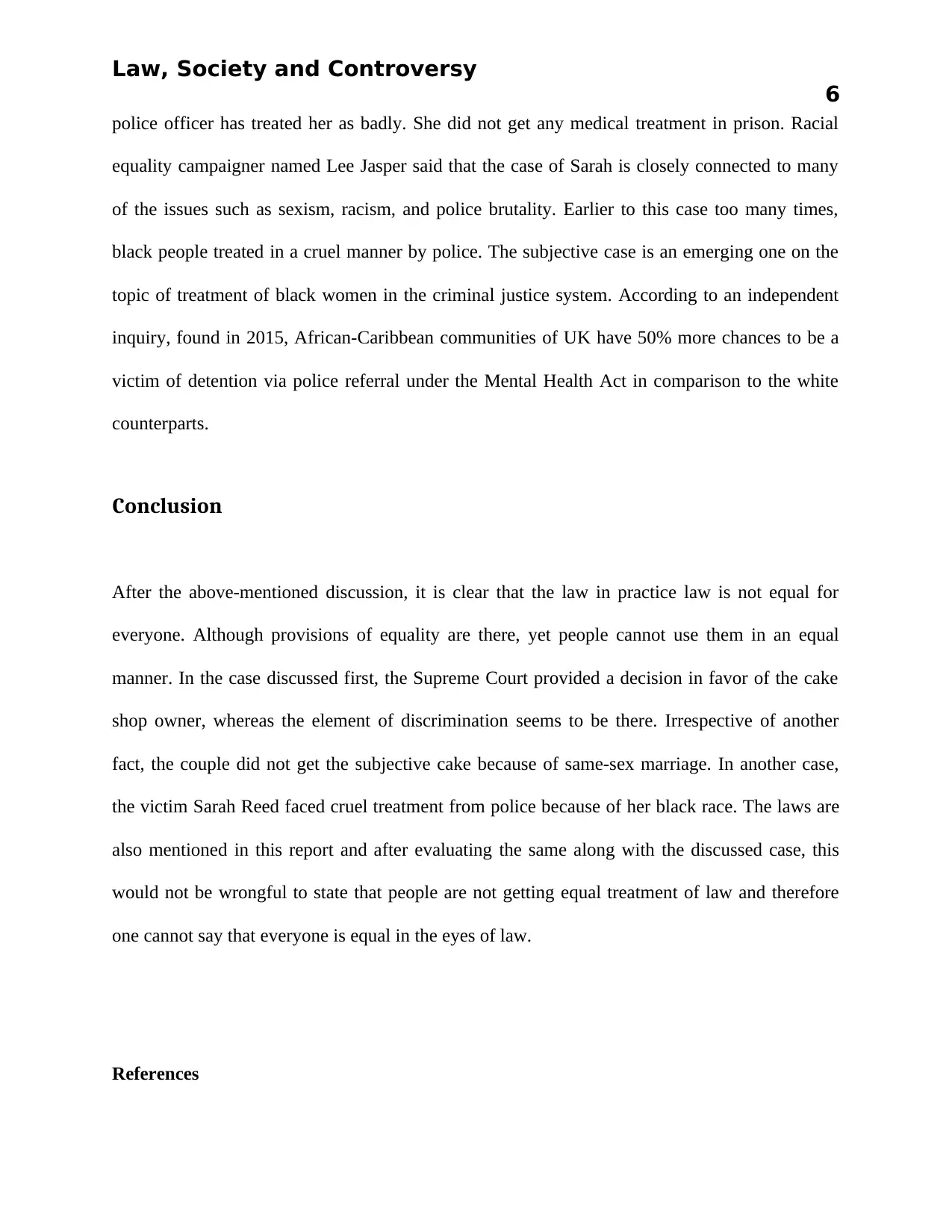
Law, Society and Controversy
6
police officer has treated her as badly. She did not get any medical treatment in prison. Racial
equality campaigner named Lee Jasper said that the case of Sarah is closely connected to many
of the issues such as sexism, racism, and police brutality. Earlier to this case too many times,
black people treated in a cruel manner by police. The subjective case is an emerging one on the
topic of treatment of black women in the criminal justice system. According to an independent
inquiry, found in 2015, African-Caribbean communities of UK have 50% more chances to be a
victim of detention via police referral under the Mental Health Act in comparison to the white
counterparts.
Conclusion
After the above-mentioned discussion, it is clear that the law in practice law is not equal for
everyone. Although provisions of equality are there, yet people cannot use them in an equal
manner. In the case discussed first, the Supreme Court provided a decision in favor of the cake
shop owner, whereas the element of discrimination seems to be there. Irrespective of another
fact, the couple did not get the subjective cake because of same-sex marriage. In another case,
the victim Sarah Reed faced cruel treatment from police because of her black race. The laws are
also mentioned in this report and after evaluating the same along with the discussed case, this
would not be wrongful to state that people are not getting equal treatment of law and therefore
one cannot say that everyone is equal in the eyes of law.
References
6
police officer has treated her as badly. She did not get any medical treatment in prison. Racial
equality campaigner named Lee Jasper said that the case of Sarah is closely connected to many
of the issues such as sexism, racism, and police brutality. Earlier to this case too many times,
black people treated in a cruel manner by police. The subjective case is an emerging one on the
topic of treatment of black women in the criminal justice system. According to an independent
inquiry, found in 2015, African-Caribbean communities of UK have 50% more chances to be a
victim of detention via police referral under the Mental Health Act in comparison to the white
counterparts.
Conclusion
After the above-mentioned discussion, it is clear that the law in practice law is not equal for
everyone. Although provisions of equality are there, yet people cannot use them in an equal
manner. In the case discussed first, the Supreme Court provided a decision in favor of the cake
shop owner, whereas the element of discrimination seems to be there. Irrespective of another
fact, the couple did not get the subjective cake because of same-sex marriage. In another case,
the victim Sarah Reed faced cruel treatment from police because of her black race. The laws are
also mentioned in this report and after evaluating the same along with the discussed case, this
would not be wrongful to state that people are not getting equal treatment of law and therefore
one cannot say that everyone is equal in the eyes of law.
References
Paraphrase This Document
Need a fresh take? Get an instant paraphrase of this document with our AI Paraphraser
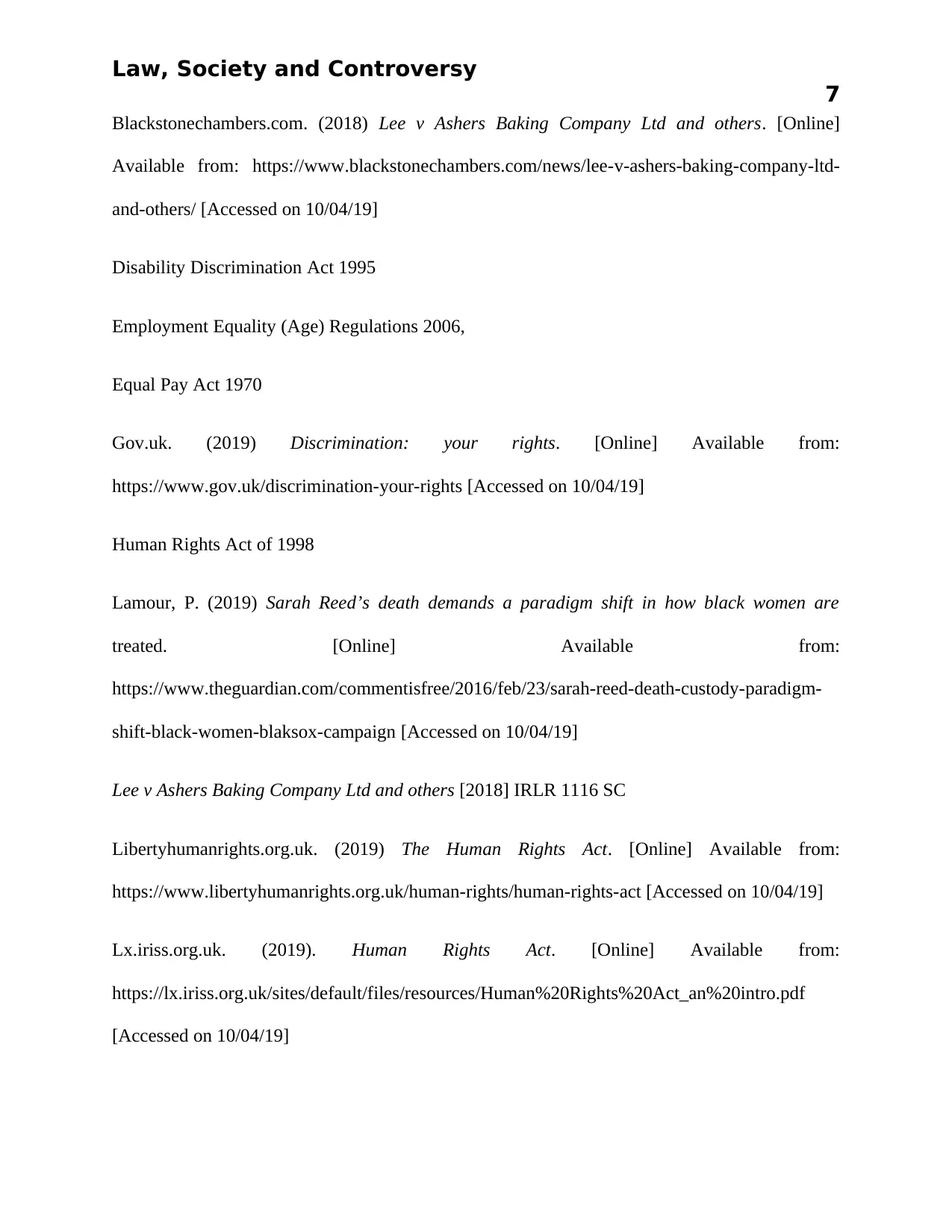
Law, Society and Controversy
7
Blackstonechambers.com. (2018) Lee v Ashers Baking Company Ltd and others. [Online]
Available from: https://www.blackstonechambers.com/news/lee-v-ashers-baking-company-ltd-
and-others/ [Accessed on 10/04/19]
Disability Discrimination Act 1995
Employment Equality (Age) Regulations 2006,
Equal Pay Act 1970
Gov.uk. (2019) Discrimination: your rights. [Online] Available from:
https://www.gov.uk/discrimination-your-rights [Accessed on 10/04/19]
Human Rights Act of 1998
Lamour, P. (2019) Sarah Reed’s death demands a paradigm shift in how black women are
treated. [Online] Available from:
https://www.theguardian.com/commentisfree/2016/feb/23/sarah-reed-death-custody-paradigm-
shift-black-women-blaksox-campaign [Accessed on 10/04/19]
Lee v Ashers Baking Company Ltd and others [2018] IRLR 1116 SC
Libertyhumanrights.org.uk. (2019) The Human Rights Act. [Online] Available from:
https://www.libertyhumanrights.org.uk/human-rights/human-rights-act [Accessed on 10/04/19]
Lx.iriss.org.uk. (2019). Human Rights Act. [Online] Available from:
https://lx.iriss.org.uk/sites/default/files/resources/Human%20Rights%20Act_an%20intro.pdf
[Accessed on 10/04/19]
7
Blackstonechambers.com. (2018) Lee v Ashers Baking Company Ltd and others. [Online]
Available from: https://www.blackstonechambers.com/news/lee-v-ashers-baking-company-ltd-
and-others/ [Accessed on 10/04/19]
Disability Discrimination Act 1995
Employment Equality (Age) Regulations 2006,
Equal Pay Act 1970
Gov.uk. (2019) Discrimination: your rights. [Online] Available from:
https://www.gov.uk/discrimination-your-rights [Accessed on 10/04/19]
Human Rights Act of 1998
Lamour, P. (2019) Sarah Reed’s death demands a paradigm shift in how black women are
treated. [Online] Available from:
https://www.theguardian.com/commentisfree/2016/feb/23/sarah-reed-death-custody-paradigm-
shift-black-women-blaksox-campaign [Accessed on 10/04/19]
Lee v Ashers Baking Company Ltd and others [2018] IRLR 1116 SC
Libertyhumanrights.org.uk. (2019) The Human Rights Act. [Online] Available from:
https://www.libertyhumanrights.org.uk/human-rights/human-rights-act [Accessed on 10/04/19]
Lx.iriss.org.uk. (2019). Human Rights Act. [Online] Available from:
https://lx.iriss.org.uk/sites/default/files/resources/Human%20Rights%20Act_an%20intro.pdf
[Accessed on 10/04/19]
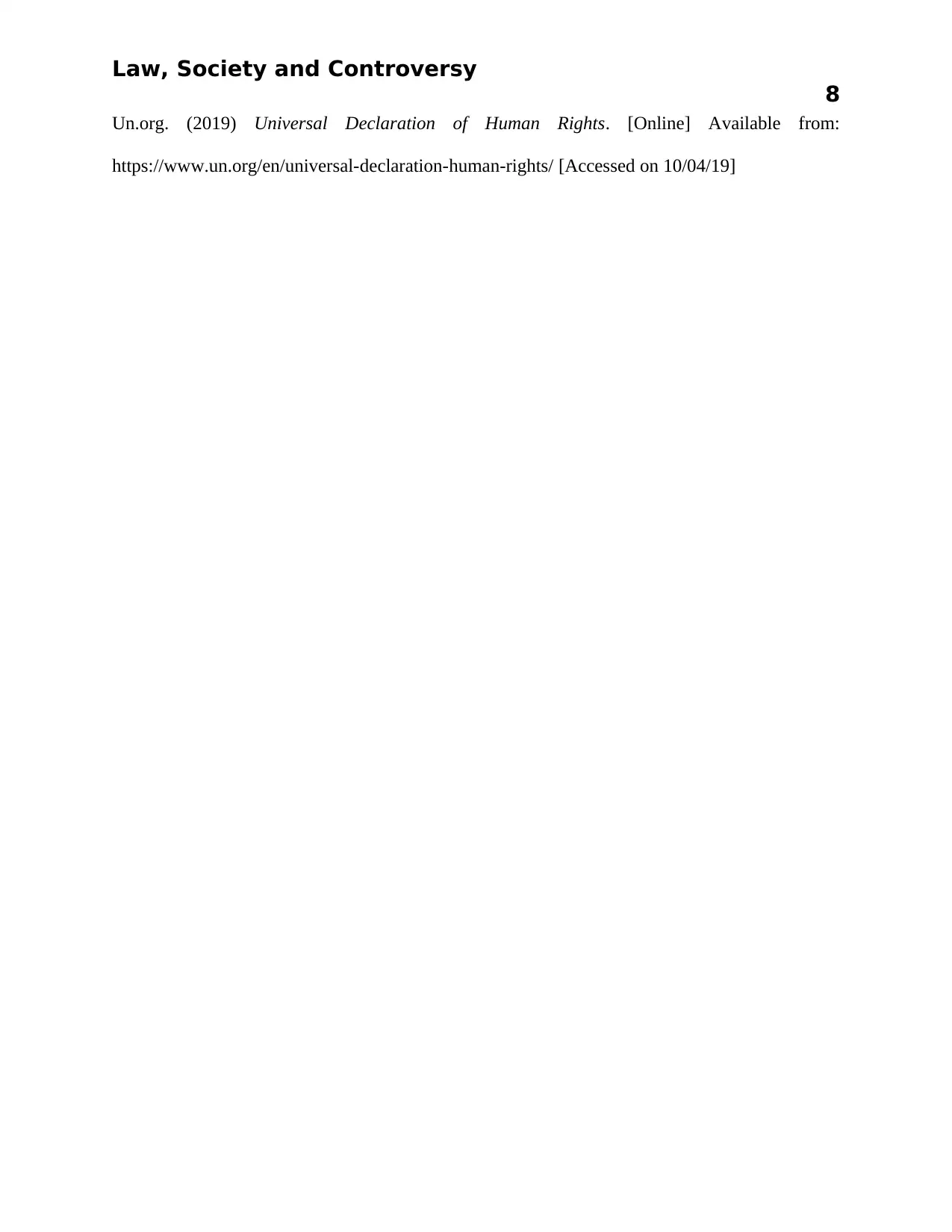
Law, Society and Controversy
8
Un.org. (2019) Universal Declaration of Human Rights. [Online] Available from:
https://www.un.org/en/universal-declaration-human-rights/ [Accessed on 10/04/19]
8
Un.org. (2019) Universal Declaration of Human Rights. [Online] Available from:
https://www.un.org/en/universal-declaration-human-rights/ [Accessed on 10/04/19]
1 out of 9
Related Documents
Your All-in-One AI-Powered Toolkit for Academic Success.
+13062052269
info@desklib.com
Available 24*7 on WhatsApp / Email
![[object Object]](/_next/static/media/star-bottom.7253800d.svg)
Unlock your academic potential
© 2024 | Zucol Services PVT LTD | All rights reserved.





